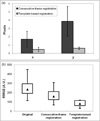Registration of dynamic contrast-enhanced MRI of the common carotid artery using a fixed-frame template-based squared-difference method
- PMID: 24123809
- PMCID: PMC3998102
- DOI: 10.1002/jmri.24224
Registration of dynamic contrast-enhanced MRI of the common carotid artery using a fixed-frame template-based squared-difference method
Abstract
Purpose: This study examines template-based squared-difference registration for motion correction in dynamic contrast-enhanced (DCE) MRI studies of the carotid artery wall and compares the results of fixed-frame template-based registration with a previously proposed consecutive-frame registration method.
Materials and methods: Ten T1-weighted black-blood, turbo spin-echo DCE-MRI studies of the carotid artery wall were used to test template-based squared-difference registration. An intermediate image from each series was selected as the fixed-frame template for registration. Squared-difference minimization was used to align each image and template. Time-intensity curves generated from data aligned with template-based squared-difference registration were compared with gold standard curves created by drawing regions of interest on each image in the series. The results were also compared with unregistered data and data after consecutive-frame squared-difference registration.
Results: An analysis of variance test of root mean-square error values between gold standard curve and curves from unregistered data and data registered with consecutive-frame and fixed-frame template-based methods was significant (P < 0.005) with template-based squared-difference registration producing curves that most closely matched the gold standard.
Conclusion: A fixed-frame template-based squared-difference registration method was proposed and validated for alignment of DCE-MRI of carotid arteries.
Keywords: registration; template-matching; vascular DCE-MRI.
Copyright © 2013 Wiley Periodicals, Inc.
Figures




References
-
- Moreno PR, Purushothaman KR, Fuster V, et al. Plaque neovascularization is increased in ruptured atherosclerotic lesions of human aorta: implications for plaque vulnerability. Circulation. 2004;110:2032–2038. - PubMed
-
- Jain RK, Finn AV, Kolodgie FD, Gold HK, Virmani R. Antiangiogenic therapy for normalization of atherosclerotic plaque vasculature: a potential strategy for plaque stabilization. Nat Clin Pract Cardiovasc Med. 2007;4:491–502. - PubMed
-
- Langheinrich AC, Kampschulte M, Buch T, Bohle RM. Vasa vasorum and atherosclerosis - Quid novi? Thromb Haemost. 2007;97:873–879. - PubMed
-
- Gaens ME, Backes WH, Rozel S, et al. Dynamic contrast-enhanced MR imaging of carotid atherosclerotic plaque: model selection, reproducibility, and validation. Radiology. 2013;266:271–279. - PubMed
Publication types
MeSH terms
Substances
Grants and funding
LinkOut - more resources
Full Text Sources
Other Literature Sources

